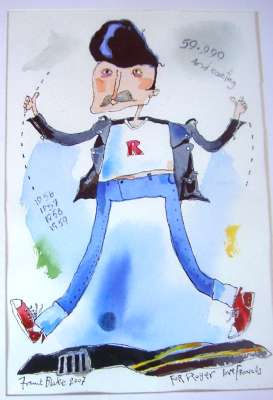[This post dates from March 2007. The rates mentioned in it have been revised subsequently. Please see the page on the website about hosting for our current rates.]
When we set up in business designing web sites, broadband was still in the labs. Home internet access was via dial-up telphone lines. I think our first PC, back in 1995, had a 28k modem though 56k became standard fairly soon after that. These figures are in bits-per-second, and as there are eight bits in a byte, the most someone with a dial-up connection can hope for is a download speed of 7,168 bytes per second. These facts of life governed the way we designed websites: the text on the pages wasn’t much of a problem but we had to compromise the quality of the photographs to ensure that download times were kept to a minimum, and we also had to limit the number of photos on each page. I remember when we could copy all of a website happily on to a 1.4 meg diskette and take it with us when we visited clients. And the 20 megabyte allocation we gave each client was many times what they might possibly need.
That was then and this is now, as Bob Dylan once memorably said. Broadband started to become available about five years ago. When BT halved the price in 2003 we took the plunge and it revolutionised the way we use the internet. At that time less than a quarter of the internet connections were broadband. The number has shot up. According to a recent report, in December 2006, there were over 13 million broadband lines in the UK, compared to just under 10 million a year ago. That’s almost 80% of UK connections, according to the Office for National Statistics.
How have we responded to this? And how have our clients? We’ve taken to compressing our pictures less, and thereby improving the quality. We’re also happier to put more pictures on each web page. But the big difference has been that our clients have come to us and asked us if we can run audio and video on their sites. Once we would have cautioned against this, now we’ll do it happily. Recent additions to various websites have included a 40 second DVD trailer for Anne Fine (1.8Mb), a 3 minute promo for the New Rope String Band (5.5Mb), a 5 minute showreel for the actor John Elnaugh (13Mb) and a 17 minute animation for Véronique Tanaka (23Mb — £1.99 payment required). Coupled with streaming technology (where the video starts to play while it is still downloading) this means the video can be seen in real time over a broadband link. On a dial-up link these files take much longer: the New Ropes promo would take at least a quarter of an hour to download, for example. So we make sure that these files are an adjunct to the site, adding extra value, but not essential to the experience.
This trend means that we now have some very large websites, and some with high bandwidth usage. It also means that the spread between our largest and our smallest client sites has grown. We found that we were running out of server space, and so we have upgraded our account with our hosting service. We also reviewed the charges we make to our clients and we have decided that we have to move away from our one-size-fits-all approach. We think that the fairest approach is to introduce a tiered structure so that only those clients who need the extra resources will be asked to pay for them.
The good news for two thirds of our clients is that we have been able to increase their allocations of both disk space (up from 20Mb to 30Mb) and monthly bandwidth (up from 300Mb to 500Mb) without increasing the annual fee, which remains at £50. Clients who need up to 60Mb of disk space and a gigabyte of bandwidth will pay £75 and for 100Mb and 2 gigabytes the fee will be £100. We will be writing to all clients in the next week or so to tell them where they fit into the new pricing structure.
Once we’ve set the level of fees we will of course monitor usage but, unlike some companies, if you bust a limit we won’t automatically pull the plug. We’ll investigate the cause and if it looks like a temporary incident we’ll see you through it. If it’s a permanent increase we will probably adjust the fee when renewal time comes around.
We’ve also been looking at our hourly rate, which was last increased in April 2005, and we are increasing this from £45 to £48 an hour. This 6.7% increase compares with a 7.1% increase in RPI over the same period. Any work that was requested before this increase was announced will be done at the old price.
Other changes we have made are to change insurers to get better cover, which now includes professional indemnity and product liability insurance. We are also changing our telephone and broadband provision from a domestic to a business service, which should mean if anything goes wrong with the phones or broadband service it gets fixed sooner. We are upgrading the broadband speed to 5.5 megabits and unlimited usage, and cancelling the second phone line to replace it with a VoIP (broadband) line. Our main phone number remains as 0191 386 8756.


